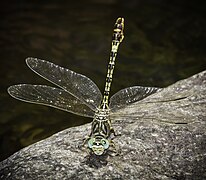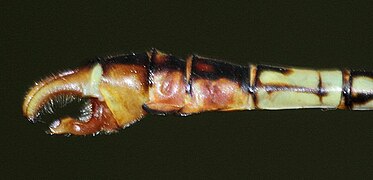Crenigomphus hartmanni
| Crenigomphus hartmanni | |
|---|---|

| |
| Male | |
| Scientific classification | |
| Kingdom: | |
| Phylum: | |
| Class: | |
| Order: | |
| Family: | |
| Genus: | |
| Species: | C. hartmanni
|
| Binomial name | |
| Crenigomphus hartmanni (Förster, 1898)
| |
Crenigomphus hartmanni (Clubbed Talontail) is a species of dragonfly in the family Gomphidae.
Distribution
It is found in Angola, the Republic of the Congo, the Democratic Republic of the Congo, Kenya, Malawi, Mozambique, Namibia, South Africa, Tanzania, Uganda, Zambia, Zimbabwe, and possibly Burundi. [1]
Status
Least Concern[2]
Habitat
Its natural habitats are subtropical or tropical moist lowland forests, dry savanna, moist savanna, subtropical or tropical dry shrubland, subtropical or tropical moist shrubland, rivers, intermittent rivers, freshwater lakes, intermittent freshwater lakes, freshwater marshes, and intermittent freshwater marshes.
Identification
The shape of the claspers are diagnostic; the tip of the epiproct is talon-shaped, and the end of the abdomen is club-shaped. The eyes are turquoise above and light grey below. The thorax is mainly yellowish green with contrasting narrow indistinct brown stripes. Abdomen is yellow and brown with a brown patch at the joint of each segment. The superior (upper) appendages are yellow, thick and turned down. The superior appendages are only slightly longer than the lower appendages. s9 half as long as s10 . On each sides of s8 - s9 are small club shaped foliations. Segment 9 half as long as s10. Segment 8, 9 and especially s10 are swollen. These swellings and small foliations give it the shape of a club. Wings are smoky and with a yellow costa. The black pterostigmas are long and narrow.[3]
Gallery
-
Male rear side view
-
Male side view
-
Male front view
-
Detail of male abdomen
-
Clubbed Talontail female
References
- ^ Dijkstra, K-D. B. & Clausnitzer, V. 2015 The dragonflies and damselflies of Eastern Africa. ISBN 978-94-91615-06-1
- ^ Clausnitzer, V. 2005. Crenigomphus hartmanni. 2006 IUCN Red List of Threatened Species. Downloaded on 9 August 2007.
- ^ Tarboton, W.R.; Tarboton, M. (2015). A guide to dragonflies and damselflies of South Africa. ISBN 978-1-77584-184-5.






